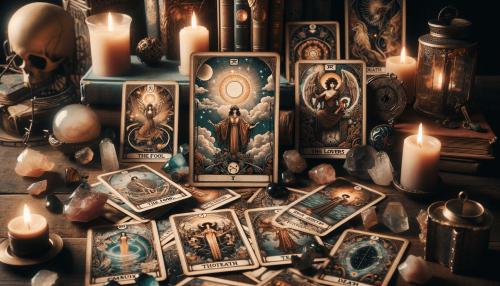Unlocking the Mysteries: A Comprehensive Guide to Tarot Card Meanings

Discovering the Tarot - A Beginner's Journey
Introduction to Tarot Cards
Welcome to the World of Tarot:
Tarot cards have been a source of fascination and mystery for centuries. Originating in the 15th century, they were initially used for games before evolving into tools for divination and self-reflection. Today, Tarot is embraced worldwide for its intricate symbolism and the profound insights it offers.
The Purpose of Tarot Reading:
Tarot reading is more than predicting the future; it's a tool for self-discovery and guidance. It helps us reflect on various aspects of our lives, offering different perspectives and deeper understanding.
Understanding the Tarot Deck
The Structure of the Deck:
A standard Tarot deck comprises 78 cards, divided into two main categories: the Major Arcana (22 cards) and the Minor Arcana (56 cards). Each card has its unique imagery, symbolism, and story.
The Major and Minor Arcana:
Major Arcana: These cards represent significant life lessons and themes. They are the heart of a Tarot deck, holding deep wisdom and insight.
Minor Arcana: These cards deal with day-to-day life, reflecting smaller-scale challenges and experiences.
The Four Suits:
The Minor Arcana is further divided into four suits, each associated with an element and aspect of human experience:
Cups (Water): Emotions, relationships, and feelings.
Swords (Air): Thoughts, words, and actions.
Wands (Fire): Energy, motivation, and passion.
Pentacles (Earth): Material aspects, career, and financial matters.
The Major Arcana Cards
Embarking on the Fool's Journey:
The Major Arcana starts with The Fool (card 0), symbolizing the beginning of a journey. Each card represents a stage in this journey, reflecting different life lessons and challenges.
Key Cards and Their Meanings:
The Fool: New beginnings, adventure, potential. Represents the start of a journey, innocence, and spontaneity.
The Lovers: Love, harmony, relationships. Symbolizes choices in personal relationships and the harmony within.
Death: Transformation, endings, new starts. Contrary to popular belief, it rarely signifies physical death but rather a significant change or transformation.
Interpreting the Major Arcana:
Each card in the Major Arcana has a unique meaning, which can vary based on the context of the reading and its position. For instance, The Empress can represent fertility and creativity, while The Hermit might suggest introspection and seeking inner wisdom.
Navigating Life's Path with Tarot - Minor Arcana and Practical Readings
The Minor Arcana Cards
Exploring Day-to-Day Experiences:
The Minor Arcana cards, comprising 56 cards, are divided into four suits: Cups, Swords, Wands, and Pentacles. Each suit corresponds to a different aspect of our daily lives, offering insights into our challenges, opportunities, and experiences.
The Suits and Their Meanings:
1. Cups (Element of Water):
Themes: Emotions, relationships, intuition.
Example: The Two of Cups often signifies partnership and mutual affection.
2. Swords (Element of Air):
Themes: Intellect, conflict, communication.
Example: The Ace of Swords can indicate a breakthrough in understanding or a new idea
.
3. Wands (Element of Fire):
Themes: Creativity, action, ambition.
Example: The Eight of Wands suggests rapid movement or quick developments.
4. Pentacles (Element of Earth):
Themes: Material aspects, career, finances.
Example: The Ten of Pentacles often represents wealth, family, and established success.
Reading Tarot Cards
Conducting a Reading:
Tarot reading is both an art and a skill. It involves drawing cards and interpreting their meanings based on their positions and relationships with each other.
Steps for a Basic Reading:
1. Setting the Intention:
Clear your mind and focus on a question or area of your life where you seek guidance.
2. Shuffling the Deck:
Shuffle the cards while keeping your question in mind.
3. Drawing the Cards:
Draw a card or multiple cards. For beginners, a simple one-card or three-card spread is a good start.
4. Interpreting the Cards:
Reflect on the symbolism and meanings of the cards. Consider how they relate to your question or situation.
Tips for Beginners:
- Trust your intuition; the first thoughts that come to mind are often significant.
- Don't be afraid to refer to a guidebook for meanings.
- Practice regularly to develop a deeper connection with the cards.
Understanding Reversals:
When a card appears upside down, it's known as a reversed card. Reversals can indicate internalized aspects of the card's meaning, a delay, or an opposite meaning.
Applying Tarot Wisdom in Daily Life
Using Tarot for Personal Growth:
Tarot can be a powerful tool for self-reflection and decision-making. Regular readings can offer insights into your personal growth, relationships, career choices, and more.
Ethical Considerations:
- Remember, Tarot is a guide, not a definitive answer.
- Use Tarot to empower, not to create fear or dependency.
- Respect the privacy and autonomy of others when reading for them.
Conclusion
A Journey of Self-Discovery:
Tarot is a journey into self-awareness and understanding. It's a personal experience where each card opens doors to deeper introspection and insight. Whether you're seeking guidance, reflection, or simply exploring the mysteries of Tarot, the cards offer a unique perspective on life's journey.
Advertise on APSense
This advertising space is available.
Post Your Ad Here
Post Your Ad Here
Comments